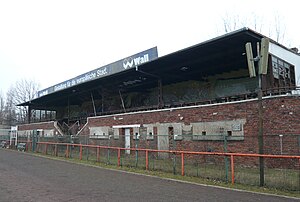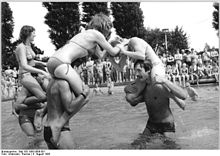BVG stadium
| BVG stadium | |
|---|---|

|
|
|
View of the stadium's grandstand (2009), demolished in 2015 |
|
| Data | |
| place |
|
| Coordinates | 52 ° 31 '46.8 " N , 13 ° 30' 8.1" E |
| opening | circa 1922 |
| demolition | Grandstand: (2015) 2016 |
| surface | Natural grass |
| architect | Jean Krämer (grandstand) |
| capacity | approx. 2000 places |
| playing area | 106 m × 80 m |
| Societies) | |
The BVG stadium (also: BVB stadium ) is a sports facility in the Berlin district of Lichtenberg in the district of the same name . It was built between 1920 and 1922 and was first used under the name of "Straßenbahnerplatz" to train the employees of the nearby Lichtenberg tram station .
Location and facilities
The stadium area is located in the north of the Lichtenberg district at Siegfriedstrasse 71. It is bounded by Siegfriedstrasse to the west, by an industrial park to the north, and by the tracks of the disused industrial railway for large companies in Herzbergstrasse to the north and south . In the past, the Lichtenberger Stadion was located to the east in the direct vicinity of the BVG Stadium . It was abandoned in 1990 and gradually recaptured by nature until the Herzberge Landscape Park was expanded. It has been completely eliminated since the 2010s, and its area has been included in the landscape park.
In addition to the actual main stadium, there are also two artificial turf courts (one large and one small), a tennis court, two beach volleyball courts , two badminton fields and several functional buildings. In addition to the grass soccer field, the stadium includes a 400-meter running track and several athletics facilities.
history
Stadion
The stadium was built around 1920 right next to the Lichtenberg Stadium, which was also completed in 1920. The covered grandstand on the eastern long side of the stadium has been done by architects Jean Kramer built and stood until its demolition 2015/2016 under monument protection . When BVG was founded in 1928, the stadium passed into their ownership and was named BVG-Stadion .
In the last weeks of the Second World War , anti-aircraft units of the German Wehrmacht were stationed on the stadium grounds and an ammunition store was set up. The Red Army fighters advancing from Frankfurter Allee concentrated on this section in their street fighting. Between 1945 and 1948, the Lichtenberg district administration set up a small rubble track from the stadium area via Reinhardsbrunner Strasse to today's Strasse Am Wasserwerk to remove the rubble that had arisen from fighting and bombing of the large neighboring industrial companies . The old flak positions were filled with rubble.
After the rubble had been dumped, the BVG took over its place again in 1948. It now served as a company sports field for the newly founded SV Berliner VG 49 . In the 1970s, the sports facility was renamed "BVB Stadium", which resulted from disputes between the East and West Berlin transport companies.
The BVG stadium was renovated at the end of the 1990s; During the earthworks, over five tons of live ammunition were found, some of which were still live, as well as an aerial bomb weighing 250 kilograms, which were then removed. After that, the stadium was given a new lawn and can again be used without restriction.
In 2016, the grandstand was demolished with the permission of the Lower Monument Protection Authority and thus removed from the Berlin monument list.
outdoor pool
When the BVG stadium was built, an outdoor swimming pool was built in 1928 on an area of approx. 20,000 m² north of the stadium area. It was used by foreign swimming competitors as a training facility for the 1932 and 1936 Summer Olympics .
After the Second World War, the swimming pool was initially not used for sports until the GDR had the facilities revised in the 1970s and the outdoor pool reopened. It was used as a summer public pool until the late 1980s and was called the 'BVB outdoor pool'. The young participants in the tent camps on the former site of the Lichtenberger Stadium were often guests in the swimming pool. From the 1990s it could no longer be used without complete renovation and was therefore removed. In 2019, two beach volleyball facilities, a small soccer field with training area lighting and two badminton fields were built on the area of the former outdoor swimming pool. The small playing field is equipped with a sand-filled artificial turf. The construction project cost around 795,000 euros.
Other structures on the stadium grounds
In the southern entrance area of the sports stadium there is a small brick house next to a porter's building, both of which also urgently need to be renovated. The sponsoring club of the BVG stadium built a multi-storey clubhouse on the site by 2010 , which fully meets the requirements for further sporting use.
Web links
- Technical data of the system. On: lsb-berlin.net
- Photos and data about the stadium. On: die-fans.de
- Pictures from the stadium on a private homepage
- Pictures from the BVB-Freibad Lichtenberg on a private homepage
Individual evidence
- ↑ a b Information from the photographer Wiesel on the grandstand in the stadium , accessed on October 22, 2018.
- ↑ a b Response of the Senate to the request of a WP user in 2017 regarding the lack of the building in the list of monuments (see discussion page).
- ^ Richard Lakowski, Klaus Dorst: Berlin. Spring 1945 , military history sketches. Military publishing house of the GDR, p. 44 f: Antifascists experience the liberation of Lichtenberg
- ↑ Angela M. Arnold, Gabriele von Griesheim: rubble, railways and districts . Self-published, 2002, pp. 124/125.
- ↑ Gone to the fire… / End of the war and a new beginning in a Berlin district (exhibition catalog). Hendrik Bäßler Verlag, Berlin 1995
- ↑ Bomb found on the sports field . In: Berliner Zeitung , January 20, 2000.
- ↑ Found more ammunition in the stadium . In: Berliner Zeitung , April 7, 2000.
- ↑ Two sports areas ready in time for Christmas. Press release from the Lichtenberg District Office, December 18, 2019.
- ^ Ronald Gorny: Lichtenberg saves schools . In: Berliner Kurier , January 7, 2009.


